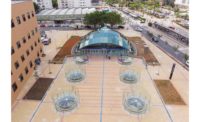
The state government of São Paulo has launched the bidding documents for a $290-million project to build a water-transmission system linking the Paraíba do Sul River to the Cantareira system, which supplies most of the São Paulo metropolitan area, with a population of 22 million people.
The Cantareira system’s water volume was down to only 6.4% of capacity by early February. The other five reservoirs that supply drinking water to the region—Alto Tietê, Guarapiranga, Cotia, Rio Grande and Rio Claro—are also well below the normal level, because of the worst drought in southeast Brazil in more than 80 years.
Authorities additionally have put São Paulo in a state of emergency, noting that water rationing could soon take place in a five days-off, two days-on schedule.
This transmission scheme was recommended in a master plan prepared for the Basic Sanitation Co. of the State of São Paulo, the regional water supply utility, several years ago. The works that will be performed will connect the Jaguari Dam, located in the basin of the river Paraíba, to the Atibainha Dam, which is part of the Cantareira system.
First, the project will transfer an average of 5,130 to 8,500 liters per second from one reservoir to another. The works include the construction of 13.5-km-long, 2-m-dia pipeline and a 6.5-km-long tunnel. The system will incorporate a pumping station that will pump the water from the Jaguari Dam to the Atibainha Dam, and also may operate in reverse.
A channel will be built to carry the water in reverse; for example, from the Cantareira system to the Paraíba do Sul River. This may help Rio de Janeiro, just in case that state suffers a serious problem of water supply in the future. This group of construction works to be tendered is expected to be completed in the second half of 2016.
The decision to build the transmission system involved a series of political negotiations in January, especially with the government of State of Rio, which has, in the basin of the river Paraíba do Sul, its main and almost only large source of water.
The public tender for the execution of those works is being carried out according to a hiring system called in Brazil RDC, which means Differentiated Regime in Public Tender, similar to the design-build approach in the U.S. Under RDC, the winning firm or team is responsible for developing the detailed design as well as construction. Brazilian engineering associations contest this model, considering that it induces and promotes strong concentration of public works in favor of a few companies.
The São Paulo state government currently is conducting the pre-qualification process and expects to choose the winning firm or team within two or three months.




Post a comment to this article
Report Abusive Comment